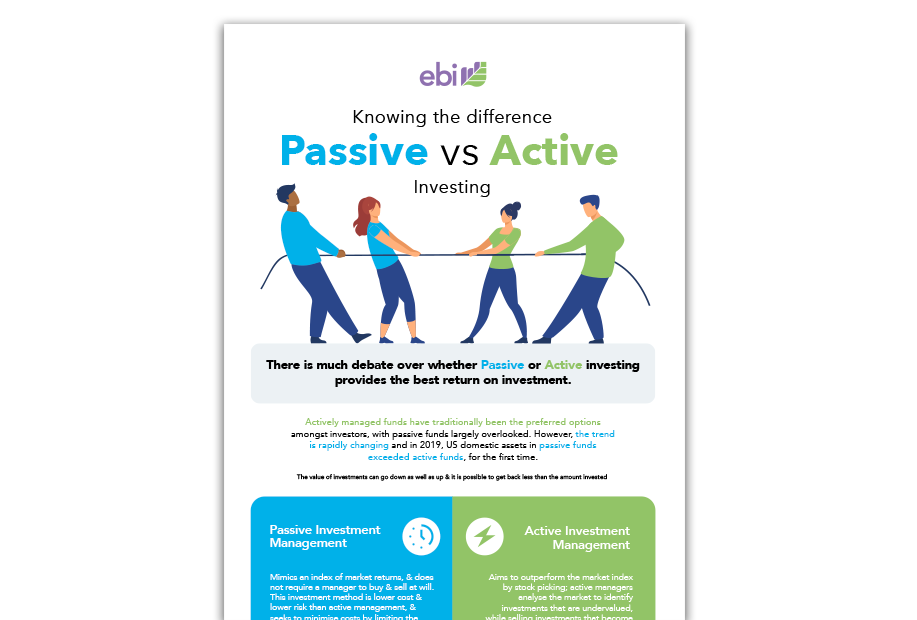Passive vs Active Investing
Traditionally, actively managed funds have been the preferred options amongst investors, with passive funds largely overlooked. The trend is rapidly changing and in 2019, for the first time, US domestic assets in passive funds exceeded active funds.

There is much debate over whether active
or passive investing provides the best return on investment.
Traditionally, actively managed funds have been the preferred options amongst investors, with passive funds largely overlooked. The trend is rapidly changing and in 2019, for the first time, US domestic assets in passive funds exceeded active funds. Passive vs active portfolio management remains a hot topic, download our infographic below to find out more.

Download our Passive vs Active investing infographic
An easy to understand infographic detailing the core differences between Passive and Active investing.
Passive Investment Management
Passive investment management mimics an index of market returns, and does not require a manager to buy and sell at will. This investment method is lower cost and lower risk than active management, and seeks to minimise costs by limiting the number of trades performed. Research shows that in the long-run, passive investments are likely to outperform active investments due to lower costs, fewer timing errors and less likelihood of poor investment choices.
Active Investment Management
Active investment management aims to outperform the market index by stock picking; active managers analyse the market to identify investments that are undervalued, while selling investments that become overvalued. Typically, fees and risk are much higher with active management, as an investment manager must continuously analyse and trade securities, with each trade incurring its own cost.
Passive vs Active Investing
Passive
Aims to capture the return of the market with a buy-and-hold strategy via index trackers and rules-based funds. They minimise trading and stay invested through good times and bad.
Active
Attempts to beat the market and deliver excess returns. This can increase risk of deviating from the market index. Research shows that only about 1% of active fund managers beat the market over the long term*.
*New Evidence on Mutual Fund Performance, D, Black. et al. 2017.
Passive
Portfolios are built around a core of ultra-low-cost index tracker funds. ebi focuses on minimising all the costs of trading and timing errors, including avoiding the cost of underperformance by active managers.
Active
Typically, costs are higher as you’re paying a manager to pick stocks, furthermore, managers will look to buy and sell securities in an attempt to beat the market, with each trade incurring a cost.
Passive
Trackers provide access to most of the world’s publicly available equities and bonds through some of the world’s largest asset managers. These portfolios aim to reduce risk via diversification.
Active
Lower diversification as the strategy involves stock picking, which will invariably result in higher volatility and lead to potential liquidity issues.
Passive
Attempts to replicate the returns of an index or asset class, does not target excess returns, instead matches the performance of an index or asset class.
Active
Attempts to add value over the returns of an index, which may be achieved by picking the next ‘winning’ stocks. Portfolios are often highly concentrated with fewer securities and less diversification.
Passive
Believes in the assumption of market efficiency explained by the concept of the Efficient Market Hypothesis (EMH). It contends that stocks will always trade at a fair price that quickly compounds available new information.
Active
Believes that markets are inefficient and stocks are often mis-priced. Active managers attempt to identify market opportunities and exploit pricing inefficiencies.
Passive
With a buy-and-hold strategy when markets go down, the portfolio goes down with it, when the market rises the passive fund matches that rise.
Active
Active managers may attempt to time markets by tactical asset allocation. They would need to make two correct decisions; when to take risk off and when to add it back, something research suggests is near impossible over the short run.



